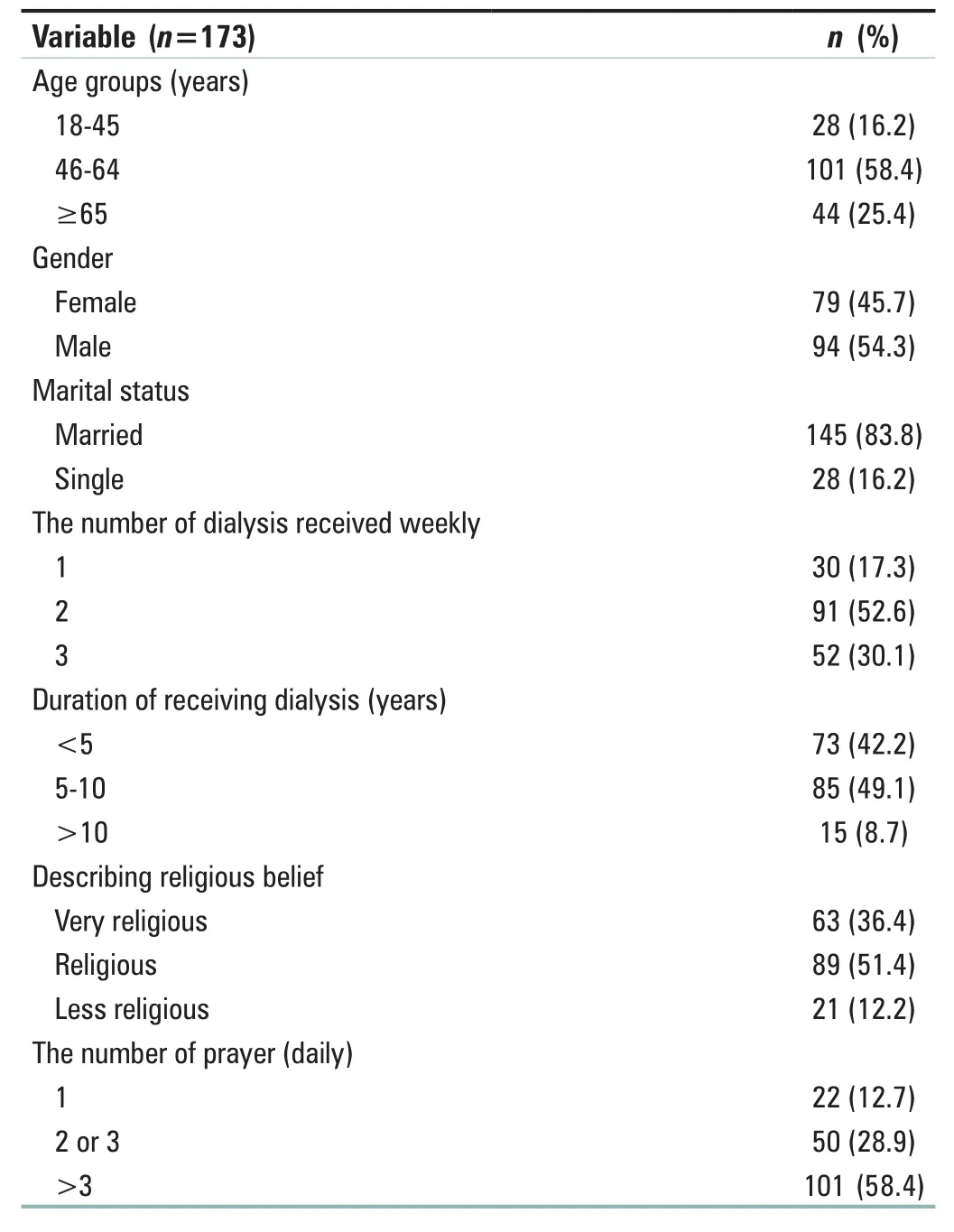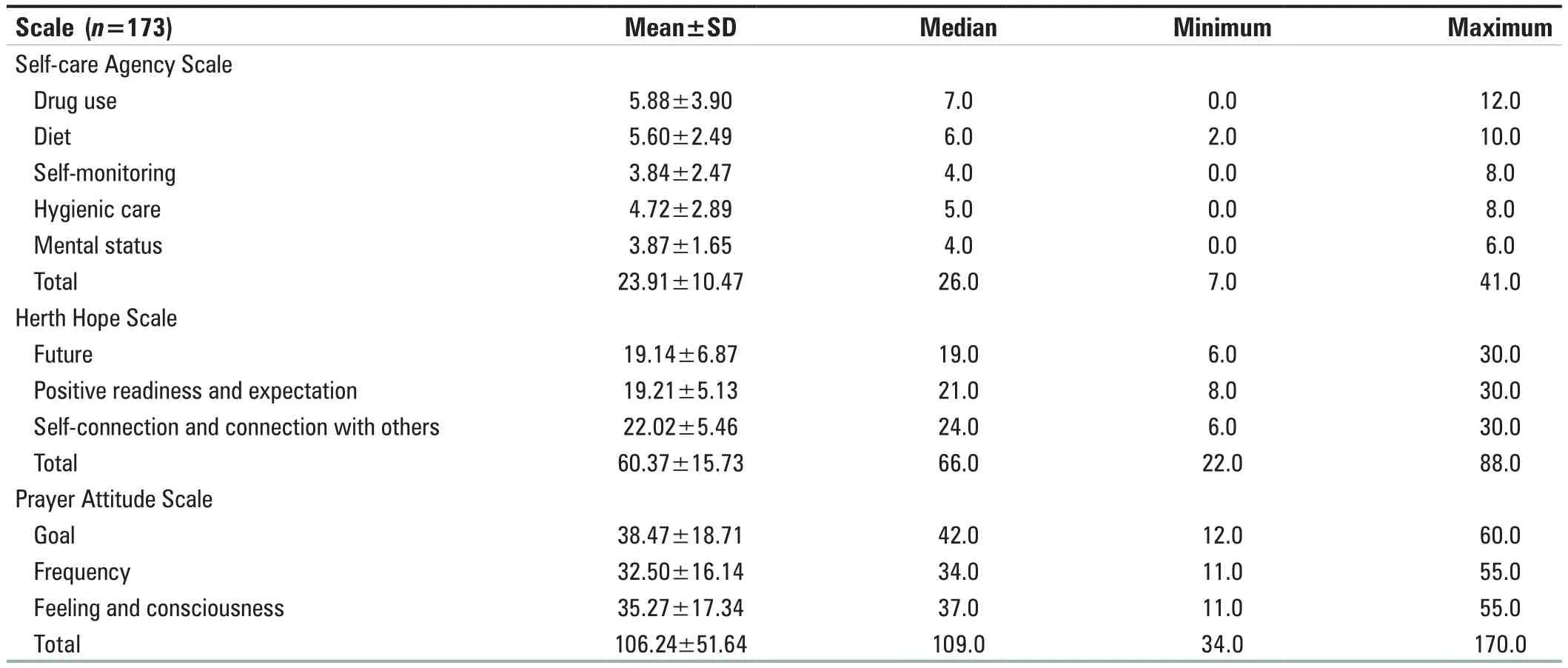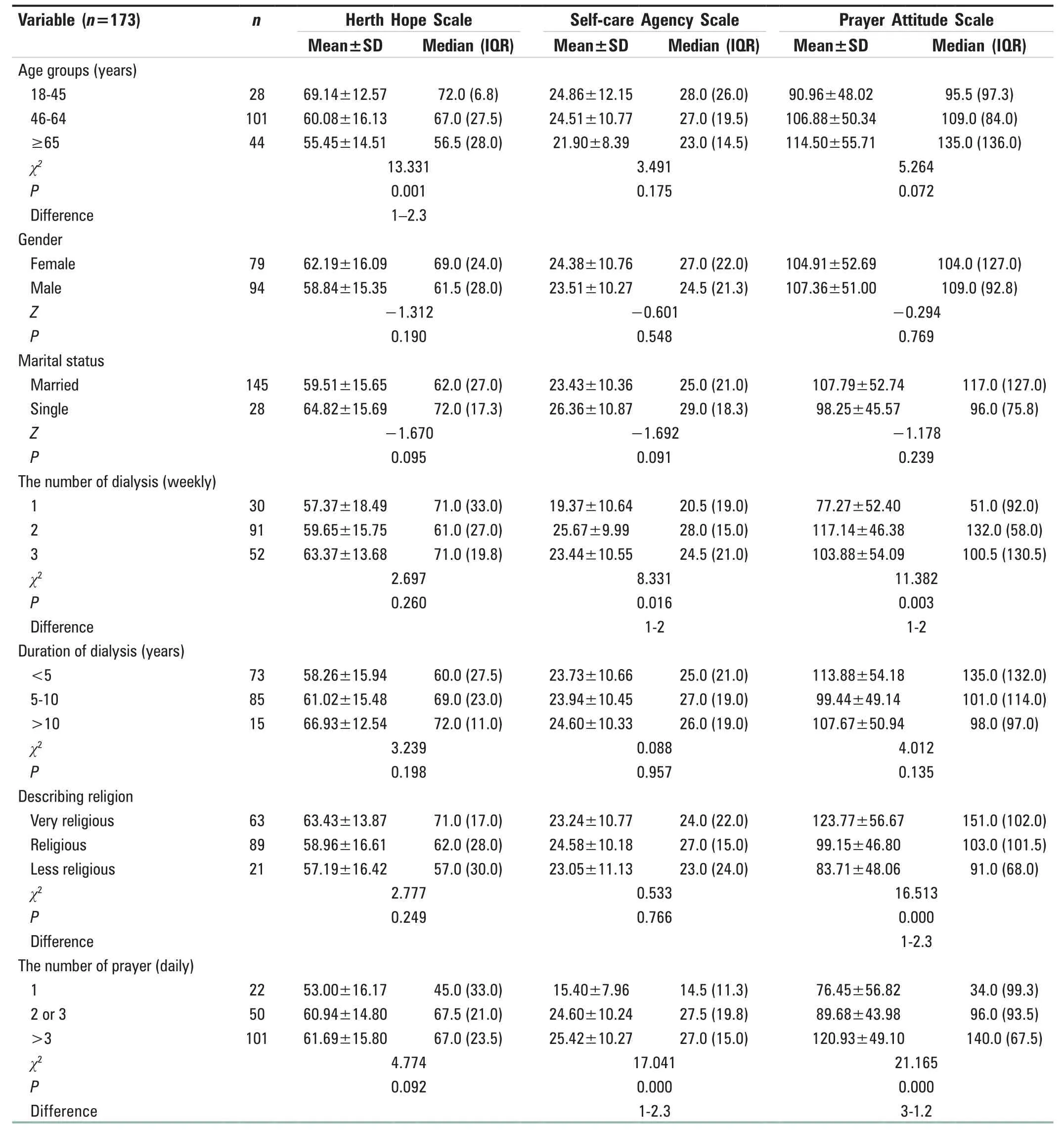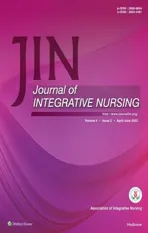Effect of prayer on the self-care agency and hope in hemodialysis patients
2022-06-30KevserSevginalASLANFundaETNKAYA
Kevser Sevgi Ünal ASLAN, Funda ÇETİNKAYA
1Fundamentals of Nursing Department, Faculty of Health Sciences, Osmaniye Korkut Ata University, Osmaniye, Turkey;2Department of Surgical Nursing, Faculty of Health Sciences,Aksaray University, Aksaray, Turkey
ABSTRACT
Background:The level of self-care of hemodialysis patients is important in controlling the disease process and symptoms.Nursing care has an important place in the process of resolving existing or developing problems of patients receiving hemodialysis treatment and in adapting to treatment.Prayer is not only a resource that encourages religious/spiritual coping, it is also a spirituality that strengthens hope.
Objective:The objective of this study is to determine whether prayer has an effect on self-care agency and hope in hemodialysis patients.
Materials and Methods:This is a descriptive and correlational study which was conducted with 180 patients in a private and a public dialysis center.The data of 173 hemodialysis patients who met the inclusion criteria were collected using personal information form, Herth Hope Scale, Self-care Agency Scale, and Prayer Attitude Scale.
Results:A positive, moderate, and statistically significant correlation was found between the Prayer Attitude Scale and total score (r = 0.144,P = 0.048) and sub-scale future (r = 0.350, P = 0.000) of Herth Hope Scale.And there was positive correlation between the Prayer Attitude Scale and the total score of Self-care Agency Scale (r = 0.599, P = 0.000) and its five sub-dimensions drug use (r = 0.566, P = 0.000), diet(r = 0.619, P = 0.000), self-monitoring (r = 0.522, P = 0.000), hygienic care (r = 0.576, P = 0.000) and mental status (r = 0.328, P = 0.000).
Conclusions:The study found that prayer had a positive effect on self-care agency and hope in hemodialysis patients.
Keywords: Hemodialysis patients, hope, prayer, self-care
INTRODUCTION
Chronic kidney disease is an important health problem increasing in Turkey and around the world.[1,2]There are 2.6 million patients who survive with dialysis and kidney transplantation all over the world.[3,4]Chronic kidney disease threatens life, causes significant workforce loss and several complications, and affects almost every age group.In chronic renal impairment, renal replacement therapy is administered such as ambulatory peritoneal dialysis, hemodialysis, and kidney transplantation.[1]Dialysis, one treatment of chronic kidney disease, prolongs patient life and significantly affects the quality of life.Although dialysis treatment causes physical disability, it also leads to reasons such as being dependent on the treatment team and the machine,changing roles in the family, and decreasing working life and social relations.These negative situations and restrictions may cause psychosocial problems such as constant anxiety and fear of short life in individuals.[5]These symptoms may negatively affect self-care agency of hemodialysis patients and cause despair.[6,7]Self-care means to fulfill the responsibilities to improve health, prevent deterioration of health, and protect psychological well-being.Orem’s Self-Care Theory focuses on the performance or practice of activities that individuals initiate and perform on their own behalf to maintain life, health, and well-being.Personal care needs can be defined as actions to provide self-care.One of them is to meet the spiritual needs included in personal care requirements.Prayer is very important in meeting these spiritual needs.Determining the hope/hopelessness levels of individuals is among the important factors in meeting the spiritual needs.[8]
Despair can be described as negative expectations and emotions in achieving a goal.However, hope is an effective coping strategy which supports one to adapt to the future,take interest in his/her future and living, and even find meaning of life.Hope is one of the important issues to be addressed in nursing care, as it can affect patients’ effort behaviors, motivation, and coping with stress and increase their self-care ability.[7]Individuals should have gained self-care ability to take responsibility of their own life, protect and promote their health, and overcome disease process or its effects.[4]Individuals who have gained self-care ability can be more positive in their life.Nurses should allocate enough time to every patient and aim to increase self-care agency by supporting psychological and social adaptation.[5]
According to the literature, in patients undergoing dialysis treatment, high spiritual well-being and religiousness are associated with a decrease in hopelessness and stress levels.[9]Spirituality is an internal emotion that has an effect on accepting the disease especially in critical states, promoting social interaction, and even affecting rehabilitation process.[10]In addition, spirituality may invite an optimistic viewpoint with an ability to have a positive attitude that can serve as an important factor in therapeutic support and personal care in general.[11]Prayer is an important spirituality experience.[12]The related literature points out that religious and spiritual practice have a healing effect on physical and psychological health and subjective well-being.Religious practices such as prayer generally take place in a social context.Prayer is not only a source that promotes religious/spiritual coping but also spirituality that empowers hope.[13]Furthermore,it helps people to face the disease and feel more powerful and safe in the whole treatment process.[14]Previous studies also showed that prayer has many beneficial effects such as better physical functionality and physiological parameters and decrease of anxiety and depression.[12,15]
It is very important to determine and meet the spiritual needs of the patients to give holistic care to the patient.Meeting the spiritual needs of the patients will contribute to the healing process and increase their self-care powers.Therefore, this study was conducted to determine whether prayer has an effect on self-care agency and hope in hemodialysis patients and what are the relationships between prayer and self-care agency and hope of hemodialysis patients.
MATERIALS AND METHODS
Design and setting
This is a descriptive and correlational study that aimed to find out whether prayer has an effect on self-care agency and hope in hemodialysis patients.It was conducted in the dialysis center of a private and a public hospital in Turkey between December 7, 2018, and February 28, 2019.
Population and Sample of the Research
Population of the study consisted of 180 hemodialysis patients in hemodialysis unit of a private and a public hospital.No sample selection was made in the study, and 173 hemodialysis patients who met the inclusion criteria and agreed to participate in the study constituted the sample of the study.
Inclusion and exclusion criteria
The inclusion criteria were being under dialysis treatment for at least 3 months, being aged 18 years and over, belonging to the religion of Islam, having no history of psychiatric disease and/or cancer diagnosis, and voluntary participation.The exclusion criteria were not speaking Turkish and having hearing and communication problems.
Study tools and data collection
The data were collected using personal information form,Herth Hope Scale, Self-care Agency Scale, and Prayer Attitude Scale.
Personal information form
This form consists of seven questions intended to identify participating patients’ age, gender, marital status, the number of weekly dialysis, duration of dialysis, and questions about religious beliefs.
Herth Hope Scale
This scale was developed in 1991 by Dr.Herth, the Dean of School of Health and Nursing, University of Minnesota,to determine hope of individuals.Dr.Herth found the internal consistency coefficients 0.89 for cancer patients,0.94 for aged people, and 0.92 for healthy adults in the reliability analyses made for the samples.[16]The Turkish adaptation of the scale was done by Aslanet al.and the internal consistency coefficient was found to be 0.84.[17]The scale comprises 30 items in three subscales including “future,” “positive readiness and expectation,”and “self-connection and connection with others.”[17]The four-point Likert scale was scored as “inappropriate”(0 point), “rarely appropriate” (1 point), “sometimes appropriate” (2 points), and “always appropriate” (3 points).The respondents were asked to select one option for each item.The Cronbach’s alpha was found to be 0.90 in this study.
Self-care Agency Scale
The scale was developed by Oren in 2010 and its validity and reliability study was carried out.The study of Oren found the Cronbach’s alpha values to be between 0.56 and 0.68 in the subscales and 0.75 in the total scale.Self-care Agency Scale consists of 22 items in five subdimensions regarding drug use, diet, self-monitoring of the patient, hygienic care,and mental status.It is a three-point Likert scale, scored from 0 to 2.Lower scores from the scale show that self-care agency is not good, while higher scores show it is good.[18,19]In this study, Cronbach’s alpha coefficient of the self-care agent scale was found to be 0.92.
Prayer Attitude Scale
This scale was developed by Albayraket al.[20]and consisted of 34 items in three dimensions including prayer goal, prayer frequency, and prayer feeling and consciousness.It is a five-point Likert scale.The subjects were asked to choose one of the options “very suitable = 5”, “suitable = 4,”partially suitable = 3,” “not suitable = 2,” and “not suitable at all = 1” for the attitude and situation in the items themselves.In this study, Cronbach’s alpha coefficient of the scale was found to be 0.99.
The data were collected through face-to-face interview and took around 20-25 min.
Ethical considerations
This study complied with the Declaration of Helsinki.Prior to the study, written permission was obtained from the Ethics Committee of Osmaniye Korkut Ata University(dated December 5th, 2018 and protocol No.2018/16/1) and the institution where the study was conducted.Based on the voluntariness principle, the participants provided their consent after being informed about the aim of the study.
Statistical analysis
The data obtained from the study were analyzed using IBM SPSS Statistics 24 (IBM, Armonk, New York, USA).The findings were interpreted using frequency tables and descriptive statistics.Nonparametric methods were used for measurement values not conforming to normal distribution.In accordance with nonparametric methods,the “Mann-WhitneyU” test (Z-table value) was used to compare the measurement values of two independent groups, and the “Kruskal-Wallis H” test (χ2-table value)was used to compare the measurement values of three or more independent groups.The Bonferroni correction was used to compare paired comparisons of the variables with significant differences for three or more groups.The Spearman’s correlation coefficient was used to analyze the correlation of the measurement values with outside normal distribution.
RESULTS
The study found that 101 patients (58.4%) aged 46-64 years,94 (54.3%) were male, 145 (83.8%) were married, and 91 (52.6%) received dialysis at least two times a week.Of the patients, 85 (49.1%) had been receiving dialysis treatment for 5-10 years, 89 (51.4%) were religious, and 101 (58.4%) prayed more than three times a day [Table 1].

Table 1: Distribution of findings on dialysis patients
The Self-care Agency Scale mean score of hemodialysis patients was 23.91 ± 10.47, Herth Hope Scale mean score was 60.37 ± 15.73, and Prayer Attitude Scale mean score was 106.24 ± 51.64 [Table 2].

Table 2: Distribution of findings from the scale
In the comparison of Self-Care Agency and demographic variables, there were statistically significant differences in the Self-care Agency Scale scores according to the number of weekly dialysis given to the patients (χ2= 8.331,P= 0.016).The significant difference was found to be between the patients who received dialysis once and those receiving it two times a week.The Self-care Agency Scale scores of those receiving dialysis two times a week were significantly higher than those receiving it once [Table 3].There were significant differences in the Self-care Agency Scale scores of the patients according to the number of prayer per day(χ2= 17.041,P= 0.000).The significant difference was found to be between the patients who prayed once and those who prayed 2 or 3 times or more.The Self-care Agency Scale scores of those praying 2 or 3 times or more per day were significantly higher than those who prayed once [Table 3].

Table 3: Comparison of total mean scores by patient findings
In the comparison of Herth Hope Scale and demographic variables, there were statistically significant differences in the Herth Hope Scale scores according to the age groups of the patients (χ2= 13.331,P= 0.001).The significant difference was found between those aged 18-45 and those aged 46-64 and over 65 years.The Herth Hope Scale scores of those aged 18-45 years were significantly higher than those aged 46-64 and over 65 years [Table 3].
In the comparison of Prayer Attitude Scale and demographic variables, there were statistically significant differences in the Prayer Attitude Scale scores according to the number of weekly dialysis given to the patients (χ2= 11.382,P= 0.003).The significant difference was found to be between the patients who received dialysis once and those receiving it two times a week.The Prayer Attitude Scale scores of those receiving dialysis two times a week were significantly higher than those receiving it once.There were significant differences in the Prayer Attitude Scale scores of the patients by self-identification as religious (χ2= 16.513,P= 0.000).The significant difference was between those who had self-identification of very religious (fully fulfilling the necessity of religion), and religious (partially fulfilling the necessity of religion) and less religious (nonreligious).The Prayer Attitude Scale scores of those who had self-identification of very religious were significantly higher than those who had self-identification of religious and less religious.There were significant differences in the Prayer Attitude Scale scores of the patients according to the number of prayer per day (χ2= 21.165,P= 0.000).The significant difference was between those who prayed more than 3 times and those who prayed once, 2 or 3 times.The Prayer Attitude Scale scores of those who prayed more than 3 times per day were significantly higher than those who prayed once, 2 or 3 times [Table 3].
Table 4 shows the correlation between the scores from the Herth Hope Scale and Self-care Agency Scale.

Table 4: Examining the relationships between the scale scores
A positive, moderate, and statistically significant correlation was found between the Prayer Attitude Scale-goal scores and Herth Hope Scale-future (r= 0.352), Self-care Agency Scale-drug use (r= 0.578) and diet (r= 0.613),self-monitoring (r= 0.567), hygienic care (r= 0.579), and the total score (r= 0,606) (P< 0.05).A positive, moderate,and statistically significant correlation was found between the Prayer Attitude Scale-frequency scores and Herth Hope Scale-future (r= 0.357) and total score (r= 0.350), Self-care Agency Scale-drug use (r= 0.561) and diet (r= 0.608),self-monitoring (r= 0.497), hygienic care (r= 0.566), and the total score (r= 0.588) (P< 0.05).
A positive, moderate, and statistically significant correlation was found between the Prayer Attitude Scale-feeling and consciousness scores and Herth Hope Scale-future (r= 0.355) and total score (r= 0.350) (P< 0.05).Self-care Agency Scale-drug use (r= 0.590) and diet (r= 0.621), self-monitoring (r= 0.518), hygienic care (r= 0.598), and the total score (r= 0.621) (P< 0.05).A positive, moderate, and statistically significant correlation was found between the Prayer Attitude Scale and total scores on Herth Hope Scale and the subscale of future, Self-care Agency Scale, drug use, diet,self-monitoring, hygienic care, and the total score [Table 4;P< 0.05].As the Prayer Attitude Scale scores increased,the Herth Hope Scale total score, future, Self-care Agency Scale-drug use, diet, self-monitoring, hygienic care, and total scores increased.
DISCUSSION
Symptoms in hemodialysis patients affect individuals’self-care agency, thus causing psychosocial problems such as despair.[7]Spirituality in individuals having psychosocial problems may let patients relax.Since there is no study in the literature investigating the correlation between self-care agency and hope of hemodialysis patients, this study can contribute to the literature.The study found that prayer had a positive effect on self-care agency and hope.
The study found that individuals’ self-care agency(23.19 ± 10.47) was moderate.In similar vein, there are some studies indicating that self-care agency of hemodialysis patients is moderate[4,21]and low level.[22]The community where study was conducted has an Islamic belief predominantly and these religious values can have positive effects on hemodialysis patients, and this may positively affect self-care agency.Furthermore, moderate level of patients’ self-care may stem from the fact that hemodialysis patients regularly go to the health institution for hemodialysis treatment, and that they are in constant contact with professional health care personnel.A statistically significant difference was found between patients’ self-care agency and the number of weekly dialysis.The Self-care Agency Scale scores of those receiving dialysis two times a week were found to be significantly higher than those receiving it once.
A statistically significant difference was found between patients’ self-care agency and the number of prayer per day.The Self-care Agency Scale scores of those praying 2 or 3 times or more per day were significantly higher than those who prayed once.Similarly, Albatnuni,[23]in his study examining the correlation between prayer and welfare,showed a significant correlation between the frequency of prayer and self-care agency.
In line with the findings of the study, it can be said that the mean score of the patients from the hope scale (60.37 ± 15.73)is higher than the scale mean value.In line with the finding from the study, other studies also found that hemodialysis patients’ hope were higher than the average.[8,24-27]Unlike these studies, Orlandiet al.[24]found patients’ hope to be low.In this study, a significant difference was found between patients’ hope and age groups (P< 0.05).Patients’ belief that their dependency will increase with their increasing age in addition to their current disease may lead them despair.In line with the study findings, Şahin[25]and Ercan[26]found that patients’ hope decreased as their age increased.
In the study, individuals’ total score from the Prayer Attitude Scale was 106.24 ± 51.64.There was a significant difference in the Prayer Attitude Scale scores of the patients according to the number of weekly dialysis they received.The mean scores of the patients receiving dialysis two times a week from the Prayer Attitude Scale were found to be high.Life of individuals undergoing dialysis treatment is affected by such reasons as having chronic disease, regularly going to dialysis center and high incidence of complications.[5]Individuals ask for help from what they have faith in for getting through their physical and mental difficulties they experience during their disease and getting healthy.[27]Religious belief of individuals during their disease may conduct them to have more religion-related acts and tendencies.
The Prayer Attitude Scale scores of those who had self-identification of very religious were significantly higher than those who had self-identification of religious and less religious.The study results show a parallelism between their beliefs and related behaviors.Previous several studies also found that religiosity and related thoughts, feelings and behavior show parallelism.[28,29]The Prayer Attitude Scale scores of those praying 3 times a day were found to be high.
A positive, moderate and statistically significant correlation was found between the total scores of hemodialysis patients from the Prayer Attitude Scale, Herth Hope Scale and its subscale of future (P< 0.05).There was no study in the literature examining the correlation between prayer and hope.Nevertheless, a study from the literature stated that prayer is spirituality that empowers hope.[13]Daştan and Buzlu[30]conducted a study in breast cancer patients and found that spiritual care had a hope-enhancing effect on these patients.
A positive, moderate and statistically significant correlation was found between the Prayer Attitude Scale scores and Self-care Agency Scale-drug use and diet, self-monitoring,hygienic care and the total score (P< 0.05).As the Prayer Attitude Scale scores increased, the Self-care Agency Scale-drug use, diet, self-monitoring, hygienic care and total scores increased accordingly.There was no study in the literature examining the correlation between prayer and self-care agency in hemodialysis patients.However, the related literature shows that belief and religious activities are effective on decreasing depression, anxiety and pain,protection from and treatment of diseases, coping with problems and increasing the quality of life.[31]Furthermore,it is reported that spirituality has a positive effect on health and well-being too.[32]In the study conducted on patients with diabetes, Moody[33]showed that spirituality had a positive effect on patients’ self-care.Religion and religiousness are mentioned to have an important role in cancer patients’ finding the meaning of life, having patience against the troubles and difficulties of the disease and having endurance.[34]Stewartet al.[35]investigated several studies that discussed the effect of religious practices as the primary and secondary variables in clinical practices in medicine in the review.The researchers who analyzed 49 studies reported that religious belief is very important for most patients and it creates positive coping mechanism in serious diseases and dependent patients.
The strength and limitations of the study
Conducting the study in a single center is one of the limitations of the study.Nongeneralization of the study results to the population due to accessing a limited number of samples is another limitation.Significant contribution of the research to the literature and the use of standard measurement tools in data collection due to the fact that there has been no study discussing the effect of prayer on self-care agency and hope in hemodialysis patients are strengths of the study.
CONCLUSIONS
The study results showed a positive, moderate, and significant correlation between prayer and self-care and hope.It is of much importance to present the correlation of spirituality and religious practices with self-care and hope and increase awareness of nurses who have an important role in holistic care delivery on this matter.In line with these conclusions,health care professionals should consider and evaluate holistically the personal characteristics of hemodialysis patients during their care and treatment process.
Acknowledgment
We would like to thank all patients receiving palliative care who agreed to participate in the study.
Financial support and sponsorship
Nil.
Conflicts of interest
There are no conflicts of interest.
杂志排行
Journal of Integrative Nursing的其它文章
- Treatment satisfaction and medication adherence among hypertensive patients in a teaching hospital in Ekiti State,Nigeria
- Midwives’ utilization of nonpharmacological pain relief measures for labor pain management: A descriptive cross-sectional study
- Psychological experience of infected individuals during the pandemic: A qualitative meta-synthesis
